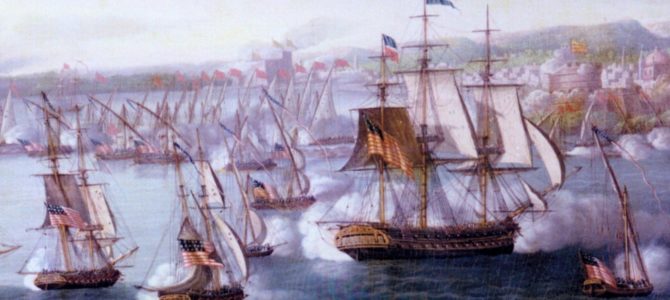
It’s there in plain sight. Spelled-out in its mission statement, the New York Times’ 1619 Project seeks to “reframe” American history to mark the year 1619 as the “true founding.” By doing so, the project will “[place] the consequences of slavery and the contributions of black Americans at the very center” of the American story.
The year 1619 was chosen for the Times’ “re-founding” to mark when the first slaves arrived in the English settlement of Jamestown. For the Times, this moment irredeemably tainted the nation. Yet viewing the centuries-old actions of men through a 21st-century lens will not solve our present social tensions. Slavery was a heart-wrenching, obstacle during America’s birth, but by no objective analysis was it the central factor of the founding as the 1619 Project claims.
Slavery Is a Blight on All Humanity, Not Just America
Slavery was and is an abomination. The ownership of one man over another is an affront to both natural law and our God-given inalienable rights as human beings. It is an evil part of America’s past—as well as that of nearly every nation on earth. The fact that slavery has a universal heritage does not absolve American slave owners, but it does provide a necessary historical context.
During the 17th century, slavery was, sadly, an accepted part of life throughout the world. By A.D. 1619, slavery had existed for more than 5000 years, dating back at least to Mesopotamia. At the time the first African slaves arrived in Jamestown, the Spanish and Portuguese had been enslaving blacks and native peoples in the New World for more than 100 years. Native American tribes had been enslaving each other for who knows how long before that.
What’s notable about the United States is not that its citizens held slaves, but that the West’s crusade to end slavery began after Jefferson penned the aspirational words of America’s founding document.
America’s Founding Ideals Aren’t Lies
Written by Nikole Hannah-Jones, the 7,600-word flagship essay of the 1619 Project asserts that “our democracy’s founding ideals were false when they were written.” Forgiving the fact that America is not a democracy but a constitutional republic, what ideals does she mean? The central organizing principle of the American founding was the preservation of life, liberty, and the pursuit of happiness.
Hannah-Jones claims, “white men who drafted those words did not believe them to be true for the hundreds of thousands of black people in their midst.” She provides no evidence or examples for this sweeping assertion. Alternatively, we know from numerous primary sources that the Founding Fathers did believe those words.
Jefferson’s original final draft of the Declaration explicitly referred to black slaves not as property but as men and castigated King George III for suppressing parliamentary efforts to prohibit or restrain “this execrable commerce” (referring to slavery). Letters written to John Jay show Alexander Hamilton hoping the Revolutionary War could lead to the emancipation of blacks and appraising them equal to whites in their abilities. Additional examples are plentiful.
Without the Founders’ Compromise, America Wouldn’t Exist
The Founders were painfully aware of the cognitive dissonance of forming a nation under the proclamation that all were created equal while maintaining slavery. They also had to face the political reality that the 13 colonies could not be united in a new nation if they immediately abolished slavery.
To insist that southern colonies immediately free their slaves would have been tantamount to demanding they destroy the economic livelihood of the entire region—a political fantasy and a suicidal non-starter. As scholar Harry V. Jaffa once pointed out, “if they had attempted to secure all the rights of all men, they would have ended in no rights secured for any men.”
With no other way to obtain the necessary support for unity and ratification, the Founders spitefully tolerated slavery’s existence, while also placing it on a path to extinction. Once the nation secured independence, American statesman of the Founding Era slashed away at slavery as quickly as prudence and political reality would allow.
American Statesman Led the Movement to End Slavery
The Northwest Ordinance of 1787 prohibited slavery in the territory that would become the states of Michigan, Ohio, Indiana, Illinois, and Wisconsin. In 1794, Congress barred American ships from engaging in the slave trade. Additional legislation in 1780 banned Americans from employment or investment in the international slave trade. Finally, the U.S. Congress officially banned the importation of slaves beginning on January 1, 1808, the earliest date allowed under the deal made to ratify the Constitution.
Far from the bastion of racism, hate and pro-slavery sentiment that the 1619 Project portrays, much of the United States was ahead of the world in ending the horror of slavery. Shortly after the signing of the Declaration, northern states took the lead. By 1804, New York, New Hampshire, Massachusetts, Vermont, Rhode Island, Connecticut, New Jersey, and Pennsylvania had passed laws that immediately or gradually abolished slavery.
This broadside assault against the institution of slavery explicitly contradicts the history sold by Hannah-Jones and the 1619 Project. If the American Founding was grounded in slavery, and the Founders didn’t believe a word of the opening of the Declaration, how does one account for these actions?
According to Hannah-Jones, one of the “primary reasons” Americans declared independence was to preserve slavery, fearful of the “growing calls” to abolish the slave trade in London. However, a closer look shows the abolitionist movement didn’t have a truly organized presence in England until 1783 when the first petition was filed by Quakers. It wasn’t until 1787 that the influential Society for Effecting the Abolition of the Slave Trade was founded.
Ultimately, more than 750,000 men died in the conflict that would finally end the wicked institution of slavery in America once and for all. When it was all over, the Civil War claimed eight times as many American lives as a percentage of the U.S. population as the Second World War.
Worldwide Abolition Lagged Behind the Northern States
Slavery wasn’t abolished until 1834 in the British Empire, 1848 in French colonial possessions, 1858 in Portuguese colonies, 1861 in Dutch Caribbean colonies, 1886 in Cuba, and 1888 in Brazil.
The pace of abolition was even worse in the non-Western part of the world. Barbary pirate slavers from North Africa enslaved more than a million Europeans until the end of WWI, three times the number of Africans sold to America. Slavery wasn’t abolished in China until 1910 (but was still practiced until 1949) and didn’t completely end in Korea until 1930. Qatar allowed slavery until 1952, Saudi Arabia and Yemen until 1962, and Mauritania until 1980—nearly 200 years after it was abolished by the state of Massachusetts.
Using the latest reliable figures from 2016, the Walk Free international human rights organization estimates that on any given day 40.3 million men, women, and children will be victims of modern-day slavery in Africa, Asia, and the Middle East. Tragically, that number is a low estimate, given the lack of reliable data from Arab states and the prevalence of slavery that still exists there.
Judging America By a Utopian Standard Is Naive
The entire framing of The New York Times’ effort deserves to be questioned. Reconstructing the American founding to the date of the first slave is a standard the Times is only placing on the United States. Is America’s “newspaper of record” about to embark on a grand venture of politely telling every other nation its celebratory founding is to be recalibrated to the date of its first instance of slavery? No, the Times’ project is deliberately—and solely—aimed at the United States.
Leftists have been engaging in this sort of deception for generations. Between the 1930s and 1980s, every perceived shortcoming of the United States was put under a microscope while the left was largely silent on the atrocities of communist tyrannies.
The left holds contempt and disdain for America’s ideals. In their heart-of-hearts, honest leftists cannot deny the unbelievable success of the United States and its institutions nor the appeal of its founding principles abroad. So, the left’s only recourse has been to mount its arguments by comparing American history to a Utopian standard they never use with any other country.
Self-criticism can be helpful, especially when it leads to improvement or the discovery of “blind spots” in one’s thinking. Yet as The Federalist’s David Marcus points out, the 1619 Project isn’t breaking new ground or telling Americans anything they haven’t already heard. Public-school textbooks have extensively covered the evils of America’s past for decades.
The central message of Howard Zinn’s popular textbook “A People’s History of the United States” is the Marxist narrative of “oppressed” versus “oppressor.” In the past 20 years, Hollywood has frequently reminded moviegoers of America’s past sins, the (undisputed) evil of slavery, and the long struggle to realize a more perfect union.
In 2017, the Smithsonian magazine warned against giving too much importance to the 1619 date, cautioning that doing so “distorts history” and places undue emphasis on “us” versus “them” narratives. You don’t say.
The 1619 Project Won’t Heal the Nation, it Will Sow Discord
The famous Roman orator Cicero held to a useful dictum: When you witness large forces on the move or scandal fills the air, ask yourself one question: Cui bono? To translate, “Whom does it benefit?” All Americans should ask themselves the same question about the Times’ ambitious revisionist history endeavor. Who benefits? For what good?
The 1619 Project is politically driven 2020 posturing dressed in the veneer of a historical “exposé.” By warping history, it hopes that dopamine hits of anger and injustice will prevent readers from engaging in objective analysis. Just in time to paint America as racist for the upcoming presidential election.
Judging by responses like the one that appeared in Slate, leftists are ready to swoop in on any criticism of the project, especially from conservatives. It’s hard to see how the entire effort won’t serve to rupture America’s partisan divide even further, and that this wasn’t part of the plan all along.
More problematically, its conclusions—that the United States was built by evil men and founded on a lie—lead to the sort of fundamental transformation leftist radicals have sought for a century. If America is as insidiously evil as the 1619 Project paints, what other recourse but to rip out its cancerous foundations root and stem? Leftists are banking that the outrage caused by the 1619 Project will provide them the political capital required to move to the next stage: a full reconfiguration of America into their image.
We Can’t Change the Past, But We Can Improve Tomorrow
America does not need further tribal rhetoric tearing up what little societal cohesion remains. The nation certainly doesn’t benefit from Times writers conducting a growing chorus of anger and grievance.
The New York Times used to at least feign impartiality. Yet the last two years give reason to question its reputation for sound judgment, especially where history is concerned. It published, for instance, one pillow-soft piece lauding mass-murderer Mao Zedong and another opining that sex was better under communist rule.
So, what if we stopped focusing on “racial identity” and the sins of men committed 400 years ago? What if, instead, we followed Dr. Martin Luther King Jr.’s advice and judged one another by the content of our character here and now—today—not in 1619, but 2019? Cui bono? To whom would that benefit? Everyone who prays for unity in our fractured republic.









